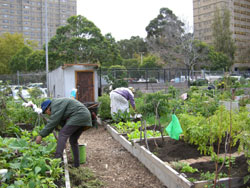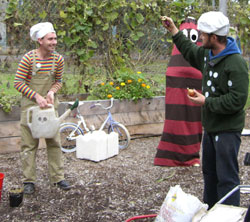Community Gardens can be found dotted around cities everywhere. Land is often supplied by local councils. It is then divided into small garden allotments, which people apply to use.
Community Gardens are essentially produce gardens and, as can be seen here at the Flemington Community Garden, often fulfill a very necessary service for people living in high-rise apartments.
This garden at Flemington has about 130 allotments, a chook shed, and rustic shelter and seating. The design includes raised beds for less-mobile gardeners.
SGA member nursery, Garden of Eden, also runs a community garden project from its site in Albert Park (shown here with the historic former railway buildings backdrop) (Photograph courtesy of Cultivating Community).
More information can be found at: www.communitygarden.org.au

Community Gardens Network
The Australian City Farms and Community Gardens Network is an informal, community-based organisation linking people interested in community gardening across Australia. More information can be found at: www.communitygarden.org.au, where there are links to state-based organisations, such as Cultivating Community in Victoria.
The aims of the network include:
- facilitating the formation and management of community gardens and similar social enterprise by making available information and, where possible, advice
- promoting the benefits of community gardening and urban agriculture.
Within the limits of its capacity, the network will:
- advocate on behalf of community gardeners
- provide information on the website that is adequate and accurate
- provide presentations and advice to local government, other institutions and communities interested in establishing community gardens
- document the development of community gardening in Australia
- provide a list of contacts through which the public may contact community gardens.

How to make a Community Garden
Here are some tips for getting a community garden up and running.
Bottom Up Approach
Working from the bottom-up is the most common:
- a group of people get together and work out what they want
- the group approaches the local council or some other institution for help in finding land and, perhaps, for other assistance
- when the group has gained access to land, they design the garden and start to cultivate it.
This approach builds ‘ownership’ of the community garden because the people who work the garden put in all the effort.
Top Down Approach
The top-down approach is favoured by professionals such as community workers and local government staff:
- the professional workers become interested in the potential of community gardens to build a sense of community or to improve the nutrition of the people they work with
- with their existing contacts with government, schools or churches they obtain land and funding more easily than citizens using the bottom-up approach
- they then have to popularise the idea of the community garden among the target group they believe will use the garden
if successful – and it might take some time – they then make use of a council landscape architect to design the garden; alternatively – and this might be the better solution because it builds ownership of the garden – they might find someone in the community who can lead a design workshop with the would-be gardeners, turning what could have been a professional-led solution into a participatory process.
The good news is that the top-down approach can succeed if the community or local government worker has the patience and persistence to build support for the garden within the community.
Once the idea has been discussed with the local community, it is a good idea is to organise a mini-bus tour of three or four existing gardens. Some councils may help with this.
Be sure to visit a variety of gardens, as to expose community members to a range of approaches to community gardening.

MORE INFORMATION
Community Gardens: A Celebration of the People, Recipes and Plants, by P. Vardy and P. Woodward, (published by Hyland House).
Related Articles:
Garden Journaling – Slow down to tune in.
As we move through the year and our gardens evolve, there's something magical about documenting the journey. Garden journaling is an art that enables…
The Importance of building soil health for a biodeverse, productive garden
Creating a thriving garden that not only sustains itself but also contributes to the broader ecosystem requires more than just sunlight and water.…



